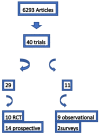Effects of Sports, Exercise Training, and Physical Activity in Children with Congenital Heart Disease-A Review of the Published Evidence
- PMID: 36832425
- PMCID: PMC9955038
- DOI: 10.3390/children10020296
Effects of Sports, Exercise Training, and Physical Activity in Children with Congenital Heart Disease-A Review of the Published Evidence
Abstract
Children and adolescents with congenital heart disease (CHD) should be encouraged to adopt a physically active lifestyle, ideally by participating in sports activities at school and sports clubs. Children with complex CHD or other risk factors (for example, pacemakers, cardioverter-defibrillators, channelopathies) may, however, need specific individualized training programs. This review article summarizes the current knowledge regarding the clinical effects of sports and exercise training on CHD and its pathophysiologic mechanisms. An evidence-based approach based on a literature search, using PubMed, Medline, CINHAL, Embase, and the Cochrane Library was conducted, last completed on 30 December 2021. In studies with 3256 CHD patients in total, including 10 randomized controlled trials, 14 prospective interventional trials, 9 observational trials, and 2 surveys, exercise training has been shown to improve exercise capacity and physical activity, motoric skills, muscular function, and quality of life. Sports and exercise training appears to be effective and safe in CHD patients. Despite being cost-efficient, training programs are currently scarcely reimbursed; therefore, support from healthcare institutions, commissioners of healthcare, and research-funding institutions is desirable. There is a strong need to establish specialized rehabilitation programs for complex CHD patients to enhance these patients' access to this treatment intervention. Further studies may be desirable to confirm these data to investigate the impact on risk profiles and to identify the most advantageous training methodology and underlying pathophysiological mechanisms.
Keywords: Fontan; adolescents; cardiorespiratory fitness; child; children; congenital heart disease; fitness; motoric skills; musculoskeletal functioning; physical activity; quality of life; rehabilitation; sports; training; youth.
Conflict of interest statement
The authors declare no conflict of interest.
Figures
Similar articles
-
ERS statement on exercise training and rehabilitation in patients with severe chronic pulmonary hypertension.Eur Respir J. 2019 Feb 28;53(2):1800332. doi: 10.1183/13993003.00332-2018. Print 2019 Feb. Eur Respir J. 2019. PMID: 30578391
-
Effects of school-based neuromuscular training on fundamental movement skills and physical fitness in children: a systematic review.PeerJ. 2022 Jul 8;10:e13726. doi: 10.7717/peerj.13726. eCollection 2022. PeerJ. 2022. PMID: 35833011 Free PMC article.
-
Youth resistance training: updated position statement paper from the national strength and conditioning association.J Strength Cond Res. 2009 Aug;23(5 Suppl):S60-79. doi: 10.1519/JSC.0b013e31819df407. J Strength Cond Res. 2009. PMID: 19620931 Review.
-
Evaluation of medical and health economic effectiveness of non-pharmacological secondary prevention of coronary heart disease.GMS Health Technol Assess. 2009 Dec 14;5:Doc16. doi: 10.3205/hta000078. GMS Health Technol Assess. 2009. PMID: 21289903 Free PMC article.
-
The future of Cochrane Neonatal.Early Hum Dev. 2020 Nov;150:105191. doi: 10.1016/j.earlhumdev.2020.105191. Epub 2020 Sep 12. Early Hum Dev. 2020. PMID: 33036834
Cited by
-
Understanding the barriers and facilitators that impact physical activity levels in children and adolescents with Congenital Heart Disease (CHD): a rapid review.BMC Public Health. 2025 Mar 28;25(1):1180. doi: 10.1186/s12889-025-22152-1. BMC Public Health. 2025. PMID: 40155820 Free PMC article. Review.
-
Combined Exercise and Mindset Training During a Pediatric Cardiac Fitness and Rehabilitation Program Benefits Youth with a Range of Congenital Heart Disease.Pediatr Cardiol. 2025 Aug;46(6):1458-1467. doi: 10.1007/s00246-024-03560-3. Epub 2024 Jul 10. Pediatr Cardiol. 2025. PMID: 38981972
-
Prevalence and impact of abnormal blood pressure on left ventricular hypertrophy in adolescents with congenital heart disease.Am J Prev Cardiol. 2025 Apr 18;22:101001. doi: 10.1016/j.ajpc.2025.101001. eCollection 2025 Jun. Am J Prev Cardiol. 2025. PMID: 40342428 Free PMC article.
-
A Multimodal Physical Program Combining Abacus Use and Exercise to Improve Motor Coordination and Flexibility in Primary School Children.J Funct Morphol Kinesiol. 2025 Jul 5;10(3):255. doi: 10.3390/jfmk10030255. J Funct Morphol Kinesiol. 2025. PMID: 40700191 Free PMC article.
-
Benefits of Physical Activity in Children with Cardiac Diseases-A Concise Summary for Pediatricians.Children (Basel). 2024 Nov 26;11(12):1432. doi: 10.3390/children11121432. Children (Basel). 2024. PMID: 39767859 Free PMC article. Review.
References
-
- Longmuir P.E., Brothers J.A., de Ferranti S.D., Hayman L.L., Van Hare G.F., Matherne G.P., Davis C.K., Joy E.A., McCrindle B.W., American Heart Association Atherosclerosis, Hypertension and Obesity in Youth Committee of the Council on Cardiovascular Disease in the Young Promotion of physical activity for children and adults with congenital heart disease: A scientific statement from the American Heart Association. Circulation. 2013;127:2147–2159. doi: 10.1161/CIR.0b013e318293688f. - DOI - PubMed
-
- Physical Activity and Health: The Benefits of Physical Activity Centers for Disease Control and Prevention Web Site. [(accessed on 9 November 2008)]; Available online: http://www.cdc.gov/physicalac-tivity/everyone/health/index.html.
-
- CDC Guidelines for school and community programs to promote lifelong physical activity among young people. Morb. Mortal. Wkly. Rep. 1997;46:1–36. - PubMed
Publication types
LinkOut - more resources
Full Text Sources


 :…
:…  : reduction; FEV1: Forced expiratory volume.
: reduction; FEV1: Forced expiratory volume. 
